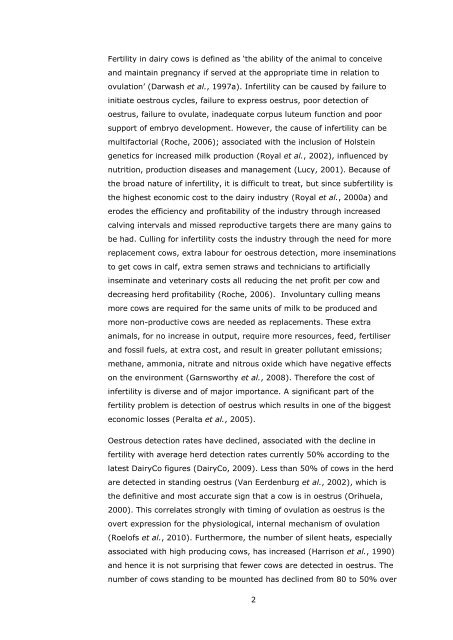novel approaches to expression and detection of oestrus in dairy cows
novel approaches to expression and detection of oestrus in dairy cows
novel approaches to expression and detection of oestrus in dairy cows
You also want an ePaper? Increase the reach of your titles
YUMPU automatically turns print PDFs into web optimized ePapers that Google loves.
Fertility <strong>in</strong> <strong>dairy</strong> <strong>cows</strong> is def<strong>in</strong>ed as ‘the ability <strong>of</strong> the animal <strong>to</strong> conceive<br />
<strong>and</strong> ma<strong>in</strong>ta<strong>in</strong> pregnancy if served at the appropriate time <strong>in</strong> relation <strong>to</strong><br />
ovulation’ (Darwash et al., 1997a). Infertility can be caused by failure <strong>to</strong><br />
<strong>in</strong>itiate oestrous cycles, failure <strong>to</strong> express <strong>oestrus</strong>, poor <strong>detection</strong> <strong>of</strong><br />
<strong>oestrus</strong>, failure <strong>to</strong> ovulate, <strong>in</strong>adequate corpus luteum function <strong>and</strong> poor<br />
support <strong>of</strong> embryo development. However, the cause <strong>of</strong> <strong>in</strong>fertility can be<br />
multifac<strong>to</strong>rial (Roche, 2006); associated with the <strong>in</strong>clusion <strong>of</strong> Holste<strong>in</strong><br />
genetics for <strong>in</strong>creased milk production (Royal et al., 2002), <strong>in</strong>fluenced by<br />
nutrition, production diseases <strong>and</strong> management (Lucy, 2001). Because <strong>of</strong><br />
the broad nature <strong>of</strong> <strong>in</strong>fertility, it is difficult <strong>to</strong> treat, but s<strong>in</strong>ce subfertility is<br />
the highest economic cost <strong>to</strong> the <strong>dairy</strong> <strong>in</strong>dustry (Royal et al., 2000a) <strong>and</strong><br />
erodes the efficiency <strong>and</strong> pr<strong>of</strong>itability <strong>of</strong> the <strong>in</strong>dustry through <strong>in</strong>creased<br />
calv<strong>in</strong>g <strong>in</strong>tervals <strong>and</strong> missed reproductive targets there are many ga<strong>in</strong>s <strong>to</strong><br />
be had. Cull<strong>in</strong>g for <strong>in</strong>fertility costs the <strong>in</strong>dustry through the need for more<br />
replacement <strong>cows</strong>, extra labour for oestrous <strong>detection</strong>, more <strong>in</strong>sem<strong>in</strong>ations<br />
<strong>to</strong> get <strong>cows</strong> <strong>in</strong> calf, extra semen straws <strong>and</strong> technicians <strong>to</strong> artificially<br />
<strong>in</strong>sem<strong>in</strong>ate <strong>and</strong> veter<strong>in</strong>ary costs all reduc<strong>in</strong>g the net pr<strong>of</strong>it per cow <strong>and</strong><br />
decreas<strong>in</strong>g herd pr<strong>of</strong>itability (Roche, 2006). Involuntary cull<strong>in</strong>g means<br />
more <strong>cows</strong> are required for the same units <strong>of</strong> milk <strong>to</strong> be produced <strong>and</strong><br />
more non-productive <strong>cows</strong> are needed as replacements. These extra<br />
animals, for no <strong>in</strong>crease <strong>in</strong> output, require more resources, feed, fertiliser<br />
<strong>and</strong> fossil fuels, at extra cost, <strong>and</strong> result <strong>in</strong> greater pollutant emissions;<br />
methane, ammonia, nitrate <strong>and</strong> nitrous oxide which have negative effects<br />
on the environment (Garnsworthy et al., 2008). Therefore the cost <strong>of</strong><br />
<strong>in</strong>fertility is diverse <strong>and</strong> <strong>of</strong> major importance. A significant part <strong>of</strong> the<br />
fertility problem is <strong>detection</strong> <strong>of</strong> <strong>oestrus</strong> which results <strong>in</strong> one <strong>of</strong> the biggest<br />
economic losses (Peralta et al., 2005).<br />
Oestrous <strong>detection</strong> rates have decl<strong>in</strong>ed, associated with the decl<strong>in</strong>e <strong>in</strong><br />
fertility with average herd <strong>detection</strong> rates currently 50% accord<strong>in</strong>g <strong>to</strong> the<br />
latest DairyCo figures (DairyCo, 2009). Less than 50% <strong>of</strong> <strong>cows</strong> <strong>in</strong> the herd<br />
are detected <strong>in</strong> st<strong>and</strong><strong>in</strong>g <strong>oestrus</strong> (Van Eerdenburg et al., 2002), which is<br />
the def<strong>in</strong>itive <strong>and</strong> most accurate sign that a cow is <strong>in</strong> <strong>oestrus</strong> (Orihuela,<br />
2000). This correlates strongly with tim<strong>in</strong>g <strong>of</strong> ovulation as <strong>oestrus</strong> is the<br />
overt <strong>expression</strong> for the physiological, <strong>in</strong>ternal mechanism <strong>of</strong> ovulation<br />
(Roel<strong>of</strong>s et al., 2010). Furthermore, the number <strong>of</strong> silent heats, especially<br />
associated with high produc<strong>in</strong>g <strong>cows</strong>, has <strong>in</strong>creased (Harrison et al., 1990)<br />
<strong>and</strong> hence it is not surpris<strong>in</strong>g that fewer <strong>cows</strong> are detected <strong>in</strong> <strong>oestrus</strong>. The<br />
number <strong>of</strong> <strong>cows</strong> st<strong>and</strong><strong>in</strong>g <strong>to</strong> be mounted has decl<strong>in</strong>ed from 80 <strong>to</strong> 50% over<br />
2
















